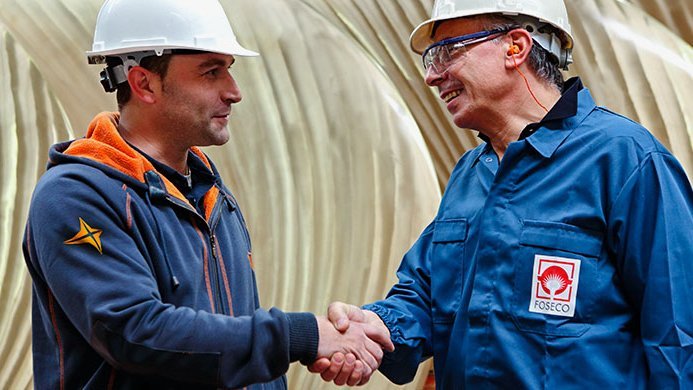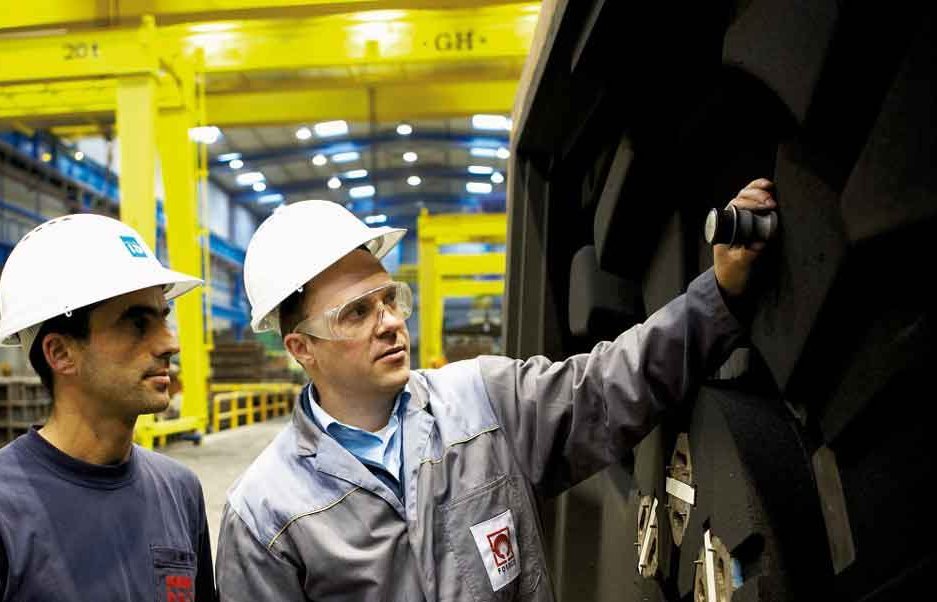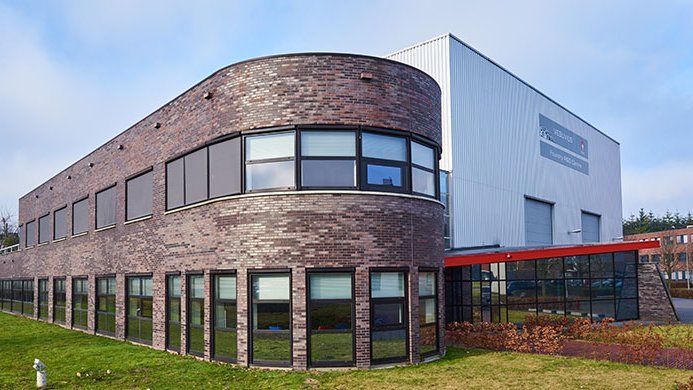

Green sand casting process
Green sand casting is a widely utilised process in the foundry industry, known for its versatility and cost-effectiveness in producing metal components. This method employs a mixture of sand, clay, water, and other additives to create moulds directly from patterns. To address challenges such as surface defects in casting and to improve overall casting quality, Foseco offers specialised foundry consumables.
Green sand casting process: an overview
- Green sand casting is a widely used and economical mould casting process suitable for both ferrous and non-ferrous metals, offering scalability for small to large production runs.
- The sand mixture, composed of silica sand, bentonite clay, water, and additives, can be reclaimed and reused multiple times, making the process both sustainable and efficient.
- Green sand moulds have limited dimensional accuracy, lower strength, and are more prone to casting defects such as sand inclusion and metal penetration, requiring careful process control.
- Foseco products like HARDCOTE SF800 coatings improve surface finish and reduce defects, while FEEDEX FEF sleeves optimise solidification, enhancing casting yield and overall quality.
Why is green sand used in casting?

Green sand is a widely used material in casting due to its versatility, cost-effectiveness, and excellent moulding properties. Comprising a mixture of high-silica sand (SiO₂), clay (typically bentonite), water, and various additives, green sand provides the necessary plasticity and strength for mould formation. The term "green" refers to the moisture content of the sand, similar to "green wood," indicating that the sand is uncured and retains its natural moisture when molten metal is introduced.
Traditionally, green sand moulds have not been coated. However, the growing need for an effective coating solution to improve cast surface quality has led to the development of HARDCOTE SF800 coating. Specifically designed for the high speed production lines commonly used in the manufacture of grey and ductile iron castings (and occasionally other alloys), this innovative product integrates seamlessly into the production environment, enabling the surface coating of moulds without compromising productivity.
Composition and benefits of green sand
- Base Sand: High-silica sand with an average grain size of 220-250 μm ensures good flowability and compaction during mould making.
- Clay Binder: Bentonite clay acts as a bonding agent, providing cohesion and strength to the mould.
- Water: Moisture activates the clay, imparting plasticity to the sand mixture.
- Additives: Materials like anthracite (coal) dust are traditionally added to enhance refractoriness, improve mould permeability, facilitate easy stripping, and achieve a superior surface finish. However, in aluminium casting, coal dust is typically omitted. Modern foundries are adopting coal dust replacements that are easier to handle and produce fewer emissions during casting.
The combination of these components results in a moulding material that is adaptable to various metals and casting processes. Green sand moulds are particularly advantageous for producing complex shapes and can be reused multiple times, making them economically and environmentally beneficial.
The green sand casting techniques
There are several green sand casting techniques to choose from. What is common to all, however, is that the green sand mix is compressed and a casting pattern impressed into that hardened block. How this is achieved can vary, with both vertical and horizontal moulding options available.
Horizontal green sand moulding
Horizontal green sand moulds – whether made via the traditional flask process or the match plate (flaskless) – comprise two parts: the cope at the top and the drag at the bottom. In the flask process, the cope and drag are formed separately by compressing the sand onto the pattern; the cope is then placed on top of drag afterwards.
In the match plate process, the cope and drag are formed simultaneously in the same mould chamber using a double-sided pattern (the match plate) that sits between the two halves as the chamber is filled with sand and compressed.
Vertical green sand moulding
In vertical green sand casting, a moulding chamber is formed by two pattern plates on either side and filled with sand from above. The pattern plates then move together to compress the sand and form the mould. To release the mould, one of the plates moves out and up, allowing the mould to be pushed out of the chamber and into contact with the previous mould; this creates the moulding cavity. As new moulds are formed, the line of moulds (mould string) is pushed towards the pouring zone.
Pouring, mould removal and re-use
In both vertical and horizontal processes, interior surfaces are created by cores of pre-cured sand, which are placed into the mould before it is sealed and locked into place. These cores can be coated with a specifically-engineered green sand coating, such as those offered by Foseco, to protect against metal penetration and burn-on defects, and to aid knock-out.
Molten metal is then poured into a pouring basin set in the top surface of the mould. It then flows down a funnel-shaped sprue and feeds into channels, or runners, which take the molten metal to the mould cavity itself via the in-gate.
Various feeding systems products like FEEDEX sleeves can be used to enhance the solidification time of feeders in order to avoid shrinkage defects and improve casting yields. Feeding systems are specific to the type of metal cast and available for cast iron, steel and non-ferrous casting applications. Additionally, Foseco's SEDEX ceramic foam filters reduce turbulence during pouring, minimising re-oxidation and inclusions in the final casting.
Once the casting solidifies, the sand is removed, and cores are extracted. This process is facilitated by release agents such as Foseco's PARTISAL, which aid in the separation of sand from the casting. In ferrous castings, magnetic separators eliminate residual metal particles, while screens filter out non-magnetic debris. The reclaimed sand is then returned to storage for reuse, with regular additions of new sand and removal of burnt sand. This way, we maintain optimal performance of the green sand mixture.
Advantages and disadvantages of green sand casting
Green sand casting is one of the most commonly used moulding processes in the foundry industry due to its cost-effectiveness, efficiency, and adaptability. However, like any casting method, it comes with both advantages and disadvantages that must be considered when selecting the best approach for metal casting.
Advantages of green sand casting
- Versatility: Green sand casting is suitable for a wide range of ferrous and non-ferrous metals and alloys, making it a flexible choice for various industries.
- Cost-effective production: The process relies on readily available materials such as silica sand, clay, and water, making it a simple and low-cost moulding method.
- High productivity: The rapid cycle times associated with green sand moulding allow for high-volume production, reducing downtime between castings.
- Capability for complex shapes: The flexibility of the sand mixture enables the production of intricate and detailed castings, including thin-walled and complex geometries.
- Scalability: Green sand casting can be used for a broad range of part sizes, shapes, and weights, from small components to large castings.
- Automation potential: Automated moulding machines enhance process efficiency by reducing cycle times and ensuring consistent mould quality.
- Quick and easy prototyping: The simplicity of the process allows for rapid prototyping and design iteration, making it an excellent choice for early-stage product development.
Disadvantages of green sand casting
- Limited dimensional accuracy: Due to the compressibility and moisture content of the sand, green sand moulds can result in slight dimensional variations and require machining for precise tolerances.
- Susceptibility to casting defects: Green sand castings are more prone to casting defects such as sand inclusion, porosity, and surface irregularities due to the inherent nature of the process.
- Lower mould strength: Compared to chemically bonded sand moulds, green sand moulds have lower strength, which may lead to deformation or erosion during pouring.
- Short shelf life of moulds: Because green sand contains moisture, the moulds cannot be stored for extended periods without risking deterioration and loss of dimensional stability.
- Suitable for most ferrous and non-ferrous metals and alloys
- Simple, low cost production
- High productivity
- Can handle complex shapes
- Flexible to a wide range of part sizes, shapes or weights
- Scalable for large production runs
- Automated mould production reduces process times
- Quick and easy prototyping
- Limited dimensional accuracy
- More prone to casting defects
- Lower mould strength
- Moulds cannot be stored for long periods
Enhancing green sand casting with Foseco solutions
Sand casting is ideal for small production batches. It also offers great versatility in the design of the final casting. To mitigate some of the common challenges in the green sand casting process, Foseco provides innovative products designed to improve green sand casting quality and efficiency.
The range of products is not limited to sand casting processes but include all foundry methods commonly employed such as lost foam casting, gravity die casting or centrifugal casting. By incorporating Foseco's advanced coatings, feeding systems, and filtration solutions, foundries can achieve higher-quality castings while maintaining the cost and productivity advantages of green sand moulding.
Recommended products for green sand foundries
To guarantee the best quality and low maintenance in green sand foundries, we always recommend "link to product" to use as the perfect feeder sleeve.
- High exothermic spot feeder sleeves
- Exothermic-insulating feeder sleeves
- Insulating sleeves
- Direct pour technology
- Coatings for high production cores
- Coatings for jobbing cores and moulds
- Equipment to apply coatings
- Speciality coatings
- Filters for steel castings
- Filters for iron castings
- Filters for aluminium and copper castings
- Gas-setting resins
- Moulding material
Further reading
Brown, J.R. (ed.), Foseco Ferrous Foundryman’s Handbook (Butterworth Heinemann; 2000), Chapter 12: Sands and green sand, pp. 146-166.
Brown, J.R. (ed.), Foseco Non-Ferrous Foundryman’s Handbook (Butterworth Heinemann; 2000), Chapter 12: Sands and sand bonding systems, pp. 149-166




